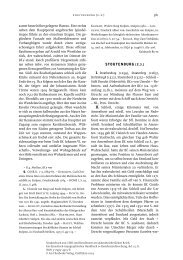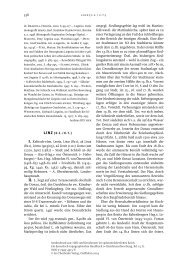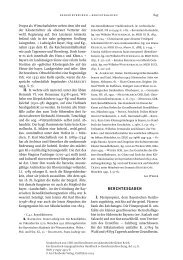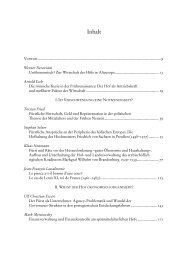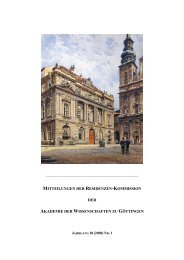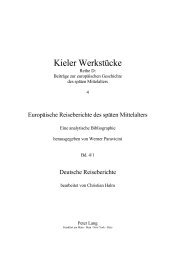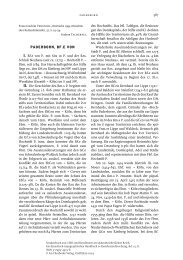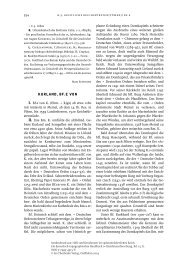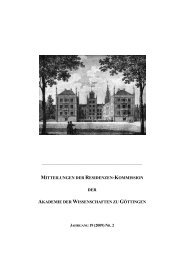MITTEILUNGEN DER RESIDENZEN-KOMMISSION DER ...
MITTEILUNGEN DER RESIDENZEN-KOMMISSION DER ...
MITTEILUNGEN DER RESIDENZEN-KOMMISSION DER ...
Sie wollen auch ein ePaper? Erhöhen Sie die Reichweite Ihrer Titel.
YUMPU macht aus Druck-PDFs automatisch weboptimierte ePaper, die Google liebt.
KOLLOQUIUMSBERICHTE<br />
Luxury and Integration<br />
Material Court Culture in Western Europe<br />
Twelfth to Eighteenth Centuries<br />
International conference held by the German Historical Institute London in co-operation with<br />
the German Historical Institute Paris and the Free University of Berlin, with additional sponsorship<br />
by the Fritz Thyssen Stiftung für Wissenschaftsförderung<br />
Cumberland Lodge, Windsor, 1-4 July 2004<br />
The aim of this conference was to examine the integration of power from a cultural historical<br />
perspective and to understand pomp at court – often criticized by contemporary observers –<br />
in terms of its function (prodigality as investment) and dysfunction (prodigality as waste)<br />
both inside and outside the particular political and social unit under consideration. The event<br />
took its title from Werner Sombart’s Luxus und Kapitalismus (2nd edn., 1922); our common<br />
intention was to revisit the seemingly irrational with an eye to its sometimes unexpectedly<br />
rational consequences.<br />
In Latin Christian Europe, the links that existed between royal, princely, and aristocratic<br />
courts furthered acculturation and cultural transfer from the end of late Antiquity onwards.<br />
For the medieval and early modern periods far-reaching effects can be observed, whether<br />
attributable to the exchange of envoys and gifts, travel, marital links, the acquisition of art, or<br />
to material compensation for services of all kinds (one term under which such forms of exchange<br />
may be subsumed is ‚patronage‘ in its widest sense). It thus becomes possible to observe<br />
and describe culturally determined power strategies calculated to have an impact on the<br />
interior structure of the group in question as well as on its environment: court culture and the<br />
representation of wealth and power were essentially a means of achieving political integration<br />
through social integration.<br />
Research on these areas has hitherto been somewhat heterogeneous in regard to both the<br />
particular subjects and periods under investigation, and the methods applied. We still lack<br />
comprehensive, interdisciplinary studies which explore the problem of integration through<br />
material culture in detail and analyse the extant sources closely enough to arrive at findings<br />
that can serve as the basis for synchronic and diachronic comparisons. With regard to the<br />
roles of permanent and ephemeral buildings, wages and pensions, clothing and jewellery,<br />
tapestries and pictures, books and instruments etc., and the ever increasing need for expenditure<br />
felt by those present at court, we know more about the late medieval and early modern<br />
periods. Nevertheless, what has been missing so far even here is a perspective which allows<br />
us to deal with all these isolated aspects in the wider context of how power systems were<br />
maintained. In other words, it remains necessary to bridge the gap between the history of art<br />
and the history of power.<br />
The aim of the conference was to ‚take stock‘ regarding these questions and to encourage<br />
future co-operation in research on material culture, with ‚power‘, ‚service and compensation‘,<br />
‚consumption‘, ‚gift culture‘, and ‚the perception of the other‘ as themes of special interest. It<br />
is hoped that in the long run this will allow us to focus more on the lesser known level below<br />
that of political and diplomatic relations.<br />
An innovative format was chosen for this conference (to good effect, as was commonly<br />
felt). It was divided into four sessions comprising between four and six speakers each. Instead<br />
31




